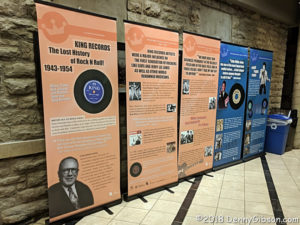 Although it didn’t feel much like it, this was actually something of a repeat. I attended a reading of KJ Sanchez’ Cincinnati King in Washington Park back in 2015. It was during a King Records celebration and drummer Philip Paul was among the musicians performing before the reading. There was music during the reading, too, but it didn’t make me think of the play as a musical. They’re calling it that now, and they’re right. I don’t doubt that my 2015 perception was off a little. In fact, I’ve probably forgotten more about that performance than I remember. But, as enjoyable as that Washington Park reading was, Cincinnati King sure has sure come a long way since then.
Although it didn’t feel much like it, this was actually something of a repeat. I attended a reading of KJ Sanchez’ Cincinnati King in Washington Park back in 2015. It was during a King Records celebration and drummer Philip Paul was among the musicians performing before the reading. There was music during the reading, too, but it didn’t make me think of the play as a musical. They’re calling it that now, and they’re right. I don’t doubt that my 2015 perception was off a little. In fact, I’ve probably forgotten more about that performance than I remember. But, as enjoyable as that Washington Park reading was, Cincinnati King sure has sure come a long way since then.
From the long list of colorful and talented people associated with King Records, Sanchez picked three to tell her tale. Syd Nathan, the label’s founder and beyond colorful owner, had to be one of them, of course. To represent Syd’s stable of singers, she chose Little Willie John whose story contains some of King’s best and worst. To help keep that volatile pair on point, she picked the guy who did the same thing for much of King’s product, long time session drummer Philip Paul.
Those great characters are portrayed by great actors. Neal Benari is a convincing and properly blustery Syd Nathans, Stanley Wayne Mathis nails Philip Paul, and Richard Crandle made me wish I could have attended just one Little Willie John performance. Benari and Mathis do sing one song each, but it’s Crandle, along with Cullen R. Titmas and Anita Welch, doing the heavy vocal lifting. Titmas and Welch kind of work their way through the King roster from Cowboy Copas to Moon Mullican and Annisteen Allen to Lula Reed. Welch has a wonderful voice and her dancing certainly adds to the show as well. The singers are backed by a top notch quartet comprised of Music Director Richard Livingston Huntley on drums, Terrell Montgomery on bass, Ralph Huntley on piano, and Seth L. Johnson on guitar.
Cincinnati King doesn’t tell the complete King story but it does paint a representative picture. From our current perspective the King Record story may seem rather sad but that could be mostly perception. King Records was successful: the sixth largest record company in the country. It was innovative: the first record company to record, manufacture, package, and distribute its product. It was progressive: generally colorblind hiring practices and minorities in key positions. It was trend setting: Little Willie John preceded James Brown, Moon Mullican preceded Jerry Lee Lewis. It was inspired: Fever, The Twist, The Train Kept A-Rollin’, and other long lived songs originated there. It was noticed: Syd Nathan is in the Rock & Roll and Bluegrass Halls of Fame and several King artists are in one or the other. KJ Sanchez gives us a feel for all of that in a highly entertaining two hours.
It’s also an informative two hours, and I could tell that parts of the story were real revelations to some of the audience. I’m no authority but I have read a fair amount about King Records and Syd Nathan over the years. Still, one piece of the story was entirely new to me. Syd Nathan, in the very early 1960s, traveled to Hamburg, Germany, to see the Beatles. It’s implied that he could have signed them but missed his chance. Whether or not an actual signing was likely, the reason for Syd not even making it to the club is telling. At some point on the day he was to see the Beatles, he watched a group of German boys walk by from his hotel room window. It’s not clear what it was about the boys that seemed menacing but the sighting caused Syd to stay in his room until time to return to London the next day. The Third Reich had been defeated little more than fifteen years earlier. Germany was not a place the Cincinnati Jew wanted to be.
I think it was the day after I saw Cincinnati King that I read a review written a few days earlier. It was very positive. I’d enjoyed the show immensely and the review reinforced my impressions. It praised the story, the actors, the musicians, and the staging. It was all flowers and sunbeams until the very last paragraph. Describing the show as “anchored in local history”, it concluded that it is “not a show that’s likely to move on to other cities and venues.” Maybe so, I thought. King was definitely a Cincinnati company. But I almost immediately started questioning the review’s conclusion. The company’s influence sure wasn’t limited to its home town. People all across the nation were once interested in its music; Why wouldn’t they be interested in its story? There’s a quote from former Rock & Roll Hall of Fame Director Terry Stewart on that panel I photographed:
There are only three places in the country that can claim to be the birthplace of Rock and Roll: New Orleans, Memphis, and Cincinnati.
I’ve no idea what plans may or may not exist for Cincinnati King. I’ve a hunch that KJ Sanchez doesn’t believe that “other cities and venues” are out of reach. I don’t.
Cincinnati King is at Playhouse in the Park through December 23.

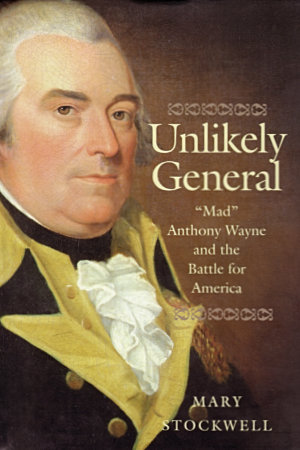 Anthony Wayne gave Fort Greene Ville and Fort Recovery their names. They were significant in both his life and mine although the level of significance is severely tilted toward Wayne. Fort Recovery is where the army led by Arthur St. Clair was nearly annihilated in 1791. It got its name when soldiers under Wayne’s command built a small fort there in 1793. Also built in 1793, Fort Greene Ville stood twenty some miles to the south and was Wayne’s home base during the Northwest Indian War. The treaty ending that war was signed there in 1795. The town that developed on the site of the abandoned fort adopted the shortened name Greenville. I grew up near the midpoint between Greenville and Fort Recovery and adopted Anthony Wayne as a hero at a very early age. I eventually figured out that much of the initial attraction was due the the cool bicorne hat he was commonly shown in, but the fact remains that I’ve known of General “Mad” Anthony Wayne nearly all of my life.
Anthony Wayne gave Fort Greene Ville and Fort Recovery their names. They were significant in both his life and mine although the level of significance is severely tilted toward Wayne. Fort Recovery is where the army led by Arthur St. Clair was nearly annihilated in 1791. It got its name when soldiers under Wayne’s command built a small fort there in 1793. Also built in 1793, Fort Greene Ville stood twenty some miles to the south and was Wayne’s home base during the Northwest Indian War. The treaty ending that war was signed there in 1795. The town that developed on the site of the abandoned fort adopted the shortened name Greenville. I grew up near the midpoint between Greenville and Fort Recovery and adopted Anthony Wayne as a hero at a very early age. I eventually figured out that much of the initial attraction was due the the cool bicorne hat he was commonly shown in, but the fact remains that I’ve known of General “Mad” Anthony Wayne nearly all of my life.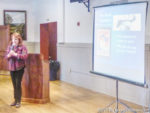
 It was probably about sixty-five years ago that I was hooked by that super groovy hat and decided that the dude under it was my hero. It was only a few years later that I saw a painting of a hat-less Wayne and was shocked to learn it was the same person. That painting might even be the same one that appears on the cover of this book. It was at least similar. I recognized that there was more to a man than his hat and Wayne survived as a childhood hero. Inside Unlikely General, Mary Stockwell reveals a lot more than a high forehead. Anthony Wayne was not, as some have interpreted his nickname, insane, but he was a long way from perfect. Perhaps the fact that I’m much older now explains why I was less shocked at learning of the imperfections than I had been at my first sight of Wayne bare-headed.
It was probably about sixty-five years ago that I was hooked by that super groovy hat and decided that the dude under it was my hero. It was only a few years later that I saw a painting of a hat-less Wayne and was shocked to learn it was the same person. That painting might even be the same one that appears on the cover of this book. It was at least similar. I recognized that there was more to a man than his hat and Wayne survived as a childhood hero. Inside Unlikely General, Mary Stockwell reveals a lot more than a high forehead. Anthony Wayne was not, as some have interpreted his nickname, insane, but he was a long way from perfect. Perhaps the fact that I’m much older now explains why I was less shocked at learning of the imperfections than I had been at my first sight of Wayne bare-headed. The question was never if there would be another book, just when and what. The answers are “now” (actually February) and “toll gates”. In my review of Cyndie L. Gerken’s first book, Marking the Miles Along the National Road Through Ohio, I noted that the huge amount of information presented in that book was only a portion of what Gerken has collected and that we would probably someday see “a Gerken penned treatise on bridges or taverns or toll houses or something else” which shows that taking three or four guesses really improves one’s chances of being right. Nailed it!
The question was never if there would be another book, just when and what. The answers are “now” (actually February) and “toll gates”. In my review of Cyndie L. Gerken’s first book, Marking the Miles Along the National Road Through Ohio, I noted that the huge amount of information presented in that book was only a portion of what Gerken has collected and that we would probably someday see “a Gerken penned treatise on bridges or taverns or toll houses or something else” which shows that taking three or four guesses really improves one’s chances of being right. Nailed it!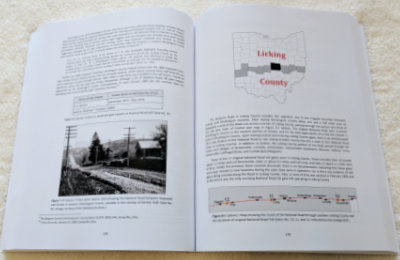 As she did with her first book, Gerken details her subject in a chapter per county moving east to west. However, before that happens, there is an introduction filled with information about the road and toll gates in general, then chapters on vehicles, toll house architecture, and bridges. Each of these, and the county chapters too, contain numerous photos and stories that color in the detailed information and keep things from becoming boring.
As she did with her first book, Gerken details her subject in a chapter per county moving east to west. However, before that happens, there is an introduction filled with information about the road and toll gates in general, then chapters on vehicles, toll house architecture, and bridges. Each of these, and the county chapters too, contain numerous photos and stories that color in the detailed information and keep things from becoming boring. Pictures of gate houses and gate keepers are to be expected, but they are not the only photo subjects presented. This might be the only book available with pictures of the world’s longest bar, grave robbers, a two-headed calf, a Spanish dime, Hopalong Cassidy, and the author’s mother riding in a goat cart. And every one of them belongs.
Pictures of gate houses and gate keepers are to be expected, but they are not the only photo subjects presented. This might be the only book available with pictures of the world’s longest bar, grave robbers, a two-headed calf, a Spanish dime, Hopalong Cassidy, and the author’s mother riding in a goat cart. And every one of them belongs.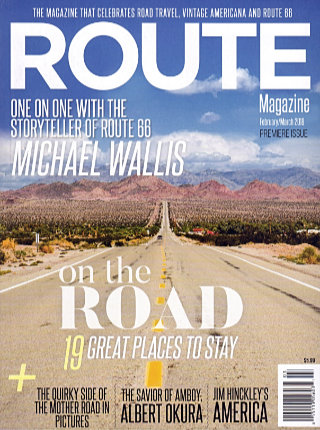
 It’s a familiar story I’d never heard before. In no way is use of the word “familiar” meant to be dismissive. It’s just my way of acknowledging that many aspects of Malcolm Fletcher’s story are to be found in the stories of thousands of other World War II soldiers. Of course, each of those stories is also unique in ways both small and large. Large happenings that make Fletcher’s story unique include the actions that earned him a bronze star and the day he watched his brother get shot and captured. Getting coffee and doughnuts from the Red Cross in February and washing clothes and shaving in May are among the not-so-large pieces of the story that make it real. Numerous photographs, maps, and drawings — many by Fletcher himself — really fill things out.
It’s a familiar story I’d never heard before. In no way is use of the word “familiar” meant to be dismissive. It’s just my way of acknowledging that many aspects of Malcolm Fletcher’s story are to be found in the stories of thousands of other World War II soldiers. Of course, each of those stories is also unique in ways both small and large. Large happenings that make Fletcher’s story unique include the actions that earned him a bronze star and the day he watched his brother get shot and captured. Getting coffee and doughnuts from the Red Cross in February and washing clothes and shaving in May are among the not-so-large pieces of the story that make it real. Numerous photographs, maps, and drawings — many by Fletcher himself — really fill things out.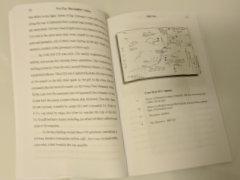 It’s a great story and well told, but there’s no denying that the mere fact that it is being shared plays a big role in setting this story apart from most of the others. The majority of those soldiers never told their story to anyone. A relative few did write it down or record it but not many saw an audience beyond family, friends, or a veterans organization. That Malcolm Fletcher wanted to share his story is obvious. He expanded his wartime notes and produced a “diary”. The title is his. Not For Morbidity’s Sake came from the fact that, as his son Michael says in the foreword, “…he took no pleasure in telling most of this story”. Malcolm Fletcher died in 1994, and Michael, with help from his brother Mark, made publication of the diary a reality. To a large degree, this meant editing their father’s writings, but they also augmented the story with information gathered from other family members, friends, and even some of the men who served with Malcolm.
It’s a great story and well told, but there’s no denying that the mere fact that it is being shared plays a big role in setting this story apart from most of the others. The majority of those soldiers never told their story to anyone. A relative few did write it down or record it but not many saw an audience beyond family, friends, or a veterans organization. That Malcolm Fletcher wanted to share his story is obvious. He expanded his wartime notes and produced a “diary”. The title is his. Not For Morbidity’s Sake came from the fact that, as his son Michael says in the foreword, “…he took no pleasure in telling most of this story”. Malcolm Fletcher died in 1994, and Michael, with help from his brother Mark, made publication of the diary a reality. To a large degree, this meant editing their father’s writings, but they also augmented the story with information gathered from other family members, friends, and even some of the men who served with Malcolm.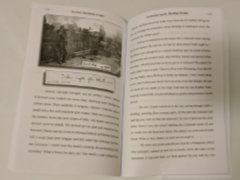 Those observations also fed some slightly philosophical thinking on the horrors of war and the brotherhood of man. He had personal experience with both. Whether the deeper of Fletcher’s thoughts came during his time in Europe or while he subsequently transcribed his notes in safety in the USA is unclear and unimportant. He was in the midst of battles where men destroyed each other with cannons, bombs, rifles, bayonets, and flame-throwers. He saw many and met a few French, Belgian, and German civilians whose world was ravaged beyond comprehension. And he was there at the end of the conflict, interacting with German and Russian soldiers to learn that “These Russies are just like us.”
Those observations also fed some slightly philosophical thinking on the horrors of war and the brotherhood of man. He had personal experience with both. Whether the deeper of Fletcher’s thoughts came during his time in Europe or while he subsequently transcribed his notes in safety in the USA is unclear and unimportant. He was in the midst of battles where men destroyed each other with cannons, bombs, rifles, bayonets, and flame-throwers. He saw many and met a few French, Belgian, and German civilians whose world was ravaged beyond comprehension. And he was there at the end of the conflict, interacting with German and Russian soldiers to learn that “These Russies are just like us.”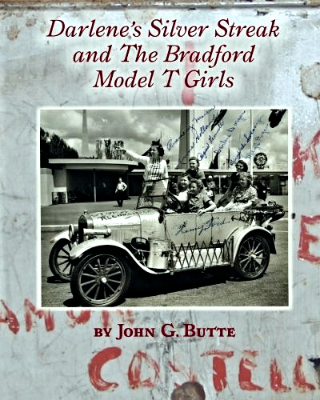 I first heard of Darlene Dorgan and her friends from a presentation on early female travelers at the Lincoln Highway Association in June. Then they were part of a similar presentation at a Route 66 conference in October. This book may have been mentioned in either or both of those presentations but, if so, it didn’t register. What finally got me interested in Darlene’s Silver Streak and The Bradford Model T Girls was when a blog I follow,
I first heard of Darlene Dorgan and her friends from a presentation on early female travelers at the Lincoln Highway Association in June. Then they were part of a similar presentation at a Route 66 conference in October. This book may have been mentioned in either or both of those presentations but, if so, it didn’t register. What finally got me interested in Darlene’s Silver Streak and The Bradford Model T Girls was when a blog I follow, 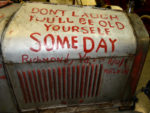
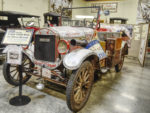
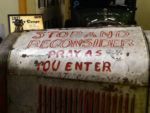
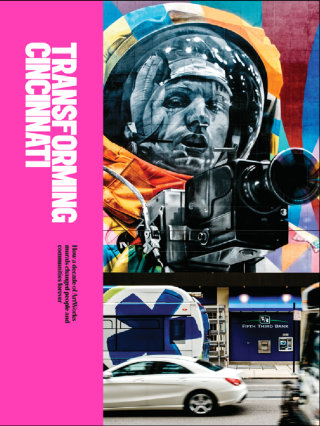 It would be nearly impossible to spend any time at all around Cincinnati and not notice that its mural population has been increasing. I’ve noticed but I didn’t understand. I didn’t understand that ArtWorks Cincinnati, a name I sometimes noticed being associated with a new mural, wasn’t just a company hired to paint some pictures on some walls. I started to understand that aspect of Cincinnati’s murals just a little when ads for Transforming Cincinnati started to appear that included pieces of the back story. At that point I thought I understood the book’s title but, as I learned when I attended the big premier nearly two weeks ago, that was probably what I understood the least. The official launch took place on November 18 at a “Book Premier & Artist Signing” hosted by Joseph-Beth Booksellers. I attended with the idea of getting a copy with a few autographs in it. I got so much more.
It would be nearly impossible to spend any time at all around Cincinnati and not notice that its mural population has been increasing. I’ve noticed but I didn’t understand. I didn’t understand that ArtWorks Cincinnati, a name I sometimes noticed being associated with a new mural, wasn’t just a company hired to paint some pictures on some walls. I started to understand that aspect of Cincinnati’s murals just a little when ads for Transforming Cincinnati started to appear that included pieces of the back story. At that point I thought I understood the book’s title but, as I learned when I attended the big premier nearly two weeks ago, that was probably what I understood the least. The official launch took place on November 18 at a “Book Premier & Artist Signing” hosted by Joseph-Beth Booksellers. I attended with the idea of getting a copy with a few autographs in it. I got so much more.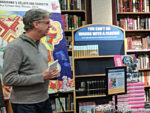
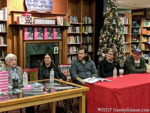
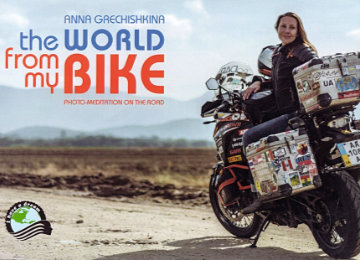 Wow! This is one of the most captivating books I have ever held in my hands. It is the product of one of the most determined woman I have ever met on one of the most exciting adventures I can imagine. Claiming to have met Anna Grechishkina is actually something of a stretch. At the 2014 Route 66 Festival in Kingman, Arizona, she joined some festival attendees for dinner. Our “meeting” consisted of a second or so of eye contact and a group hello. But I learned of her dream and her plans to fulfill it and I have followed her journey from that point on.
Wow! This is one of the most captivating books I have ever held in my hands. It is the product of one of the most determined woman I have ever met on one of the most exciting adventures I can imagine. Claiming to have met Anna Grechishkina is actually something of a stretch. At the 2014 Route 66 Festival in Kingman, Arizona, she joined some festival attendees for dinner. Our “meeting” consisted of a second or so of eye contact and a group hello. But I learned of her dream and her plans to fulfill it and I have followed her journey from that point on.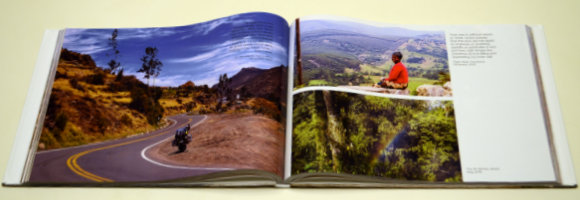
 This could be the charm associated with third attempts, or it could be the out associated with third strikes. Seriously, though, I doubt it is either. Neither of my first two books,
This could be the charm associated with third attempts, or it could be the out associated with third strikes. Seriously, though, I doubt it is either. Neither of my first two books, 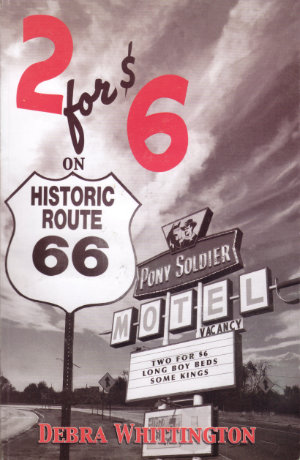 I wish I had $6 or even 6¢ for every time I’ve stood by an old motel or diner and wished that the aging walls could talk. There are no talking walls here but 2 for $6 on Route 66 does contain the memories of someone who spent a whole lot of time with some very interesting walls. Author Debra Whittington married into the motel business; The man she married was born into it.
I wish I had $6 or even 6¢ for every time I’ve stood by an old motel or diner and wished that the aging walls could talk. There are no talking walls here but 2 for $6 on Route 66 does contain the memories of someone who spent a whole lot of time with some very interesting walls. Author Debra Whittington married into the motel business; The man she married was born into it.